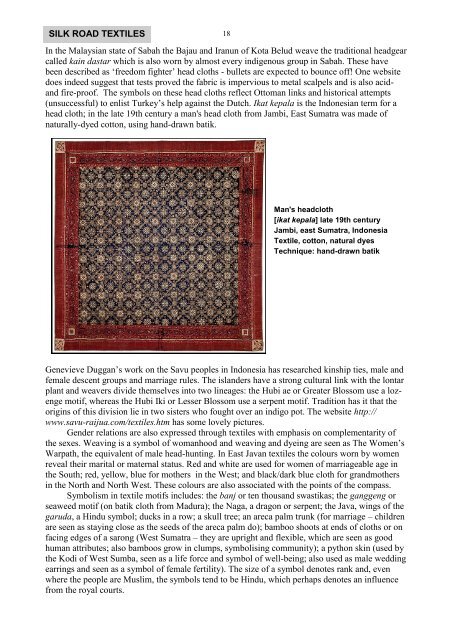ASIAN TEXTILES - OATG. Oxford Asian Textile Group
ASIAN TEXTILES - OATG. Oxford Asian Textile Group
ASIAN TEXTILES - OATG. Oxford Asian Textile Group
- No tags were found...
You also want an ePaper? Increase the reach of your titles
YUMPU automatically turns print PDFs into web optimized ePapers that Google loves.
SILK ROAD <strong>TEXTILES</strong>18In the Malaysian state of Sabah the Bajau and Iranun of Kota Belud weave the traditional headgearcalled kain dastar which is also worn by almost every indigenous group in Sabah. These havebeen described as ‗freedom fighter‘ head cloths - bullets are expected to bounce off! One websitedoes indeed suggest that tests proved the fabric is impervious to metal scalpels and is also acidandfire-proof. The symbols on these head cloths reflect Ottoman links and historical attempts(unsuccessful) to enlist Turkey‘s help against the Dutch. Ikat kepala is the Indonesian term for ahead cloth; in the late 19th century a man's head cloth from Jambi, East Sumatra was made ofnaturally-dyed cotton, using hand-drawn batik.Man's headcloth[ikat kepala] late 19th centuryJambi, east Sumatra, Indonesia<strong>Textile</strong>, cotton, natural dyesTechnique: hand-drawn batikGenevieve Duggan‘s work on the Savu peoples in Indonesia has researched kinship ties, male andfemale descent groups and marriage rules. The islanders have a strong cultural link with the lontarplant and weavers divide themselves into two lineages: the Hubi ae or Greater Blossom use a lozengemotif, whereas the Hubi Iki or Lesser Blossom use a serpent motif. Tradition has it that theorigins of this division lie in two sisters who fought over an indigo pot. The website http://www.savu-raijua.com/textiles.htm has some lovely pictures.Gender relations are also expressed through textiles with emphasis on complementarity ofthe sexes. Weaving is a symbol of womanhood and weaving and dyeing are seen as The Women‘sWarpath, the equivalent of male head-hunting. In East Javan textiles the colours worn by womenreveal their marital or maternal status. Red and white are used for women of marriageable age inthe South; red, yellow, blue for mothers in the West; and black/dark blue cloth for grandmothersin the North and North West. These colours are also associated with the points of the compass.Symbolism in textile motifs includes: the banj or ten thousand swastikas; the ganggeng orseaweed motif (on batik cloth from Madura); the Naga, a dragon or serpent; the Java, wings of thegaruda, a Hindu symbol; ducks in a row; a skull tree; an areca palm trunk (for marriage – childrenare seen as staying close as the seeds of the areca palm do); bamboo shoots at ends of cloths or onfacing edges of a sarong (West Sumatra – they are upright and flexible, which are seen as goodhuman attributes; also bamboos grow in clumps, symbolising community); a python skin (used bythe Kodi of West Sumba, seen as a life force and symbol of well-being; also used as male weddingearrings and seen as a symbol of female fertility). The size of a symbol denotes rank and, evenwhere the people are Muslim, the symbols tend to be Hindu, which perhaps denotes an influencefrom the royal courts.
















